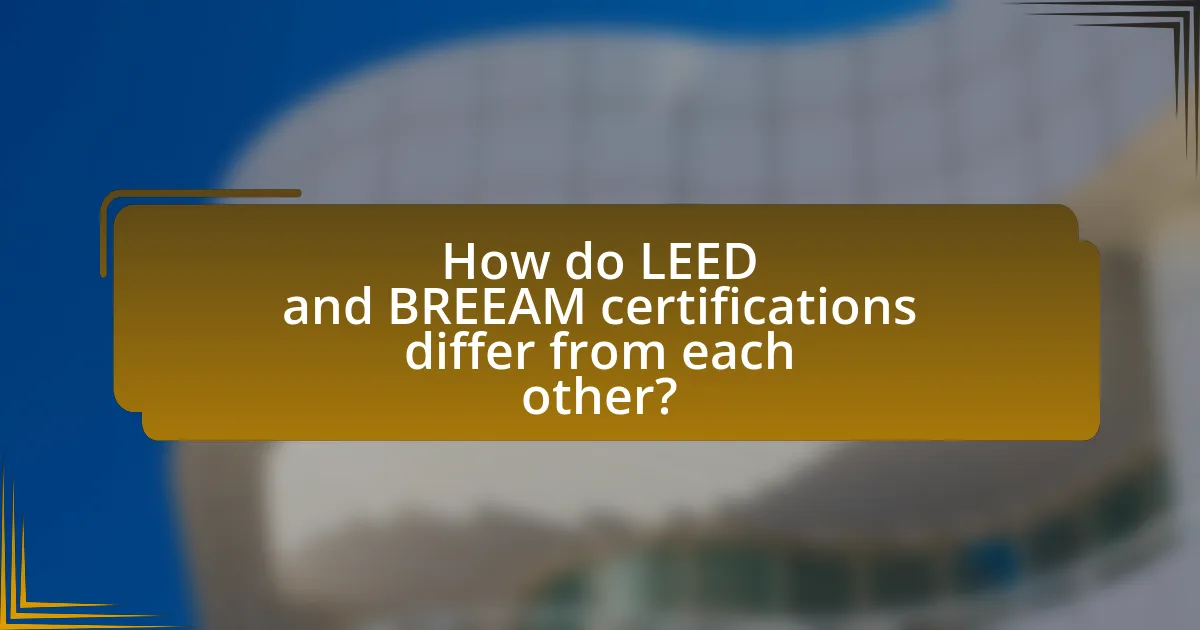Certifications such as LEED (Leadership in Energy and Environmental Design) and BREEAM (Building Research Establishment Environmental Assessment Method) are essential in advancing sustainable design practices by providing standardized frameworks for evaluating the environmental performance of buildings. These certifications promote energy efficiency, water conservation, and sustainable material use, significantly reducing the ecological footprint of construction projects. The article explores how LEED and BREEAM influence design decisions, project funding, and investment opportunities, while also examining their distinct assessment criteria and geographical considerations. Additionally, it highlights the challenges and benefits associated with each certification, as well as emerging trends and best practices for achieving certification in sustainable design.

What is the role of certifications like LEED and BREEAM in sustainable design practices?
Certifications like LEED (Leadership in Energy and Environmental Design) and BREEAM (Building Research Establishment Environmental Assessment Method) play a crucial role in promoting sustainable design practices by providing standardized frameworks for assessing the environmental performance of buildings. These certifications encourage the adoption of sustainable practices by setting benchmarks for energy efficiency, water conservation, and material sustainability, which are essential for reducing the ecological footprint of construction projects.
For instance, LEED certification has been linked to a 20-30% reduction in energy use and a 30-50% reduction in water use in certified buildings, demonstrating its effectiveness in promoting sustainability. Similarly, BREEAM has been recognized for its comprehensive approach, assessing factors such as management, health and well-being, and pollution, which collectively contribute to a building’s overall sustainability profile. These certifications not only guide architects and builders in implementing sustainable practices but also enhance marketability and value for properties, as consumers increasingly prioritize environmentally responsible options.
How do LEED and BREEAM certifications promote sustainability?
LEED and BREEAM certifications promote sustainability by establishing rigorous standards for environmental performance in building design, construction, and operation. These certifications encourage the use of sustainable materials, energy-efficient systems, and water conservation practices, which collectively reduce the ecological footprint of buildings. For instance, LEED-certified buildings can achieve up to 40% energy savings compared to conventional buildings, while BREEAM emphasizes reducing carbon emissions and enhancing biodiversity. Both certifications also foster a culture of sustainability by incentivizing innovation and continuous improvement in building practices, thereby contributing to long-term environmental benefits.
What are the key principles behind LEED certification?
The key principles behind LEED certification include sustainable site development, water efficiency, energy efficiency, material selection, and indoor environmental quality. These principles aim to reduce the environmental impact of buildings and promote sustainable practices. For instance, sustainable site development encourages the use of previously developed land to minimize habitat destruction, while water efficiency focuses on reducing water consumption through innovative fixtures and landscaping. Energy efficiency emphasizes the use of renewable energy sources and energy-saving technologies, which can lead to significant reductions in greenhouse gas emissions. Material selection promotes the use of sustainable and recycled materials, and indoor environmental quality ensures that building occupants have access to healthy indoor environments. Collectively, these principles guide the design, construction, and operation of buildings to achieve sustainability goals.
What are the key principles behind BREEAM certification?
The key principles behind BREEAM certification include sustainable site development, water efficiency, energy performance, material selection, indoor environmental quality, and innovation. BREEAM evaluates the environmental impact of buildings throughout their lifecycle, promoting resource efficiency and reducing carbon emissions. For instance, BREEAM-certified buildings typically demonstrate a significant reduction in energy use, with studies showing that they can achieve up to 30% lower energy consumption compared to non-certified buildings. This certification framework encourages best practices in sustainable design, construction, and operation, ultimately contributing to a more sustainable built environment.
Why are certifications important for sustainable design?
Certifications are important for sustainable design because they provide a standardized framework for assessing and validating environmentally responsible practices. These certifications, such as LEED and BREEAM, establish clear criteria that guide designers and builders in implementing sustainable strategies, ensuring that projects meet specific environmental performance benchmarks. For instance, LEED-certified buildings are known to use 25% less energy and 11% less water than non-certified buildings, demonstrating the tangible benefits of adhering to these standards. By obtaining certifications, stakeholders can enhance credibility, attract investment, and promote a culture of sustainability within the industry.
How do certifications influence design decisions?
Certifications such as LEED and BREEAM significantly influence design decisions by establishing benchmarks for sustainability that designers must meet. These certifications guide architects and engineers in selecting materials, optimizing energy efficiency, and implementing sustainable practices throughout the design process. For instance, LEED certification requires adherence to specific criteria related to energy use, water efficiency, and indoor environmental quality, compelling designers to prioritize eco-friendly solutions. Research indicates that buildings certified under these programs often achieve lower operational costs and higher market value, reinforcing the importance of certifications in shaping design choices.
What impact do certifications have on project funding and investment?
Certifications such as LEED and BREEAM significantly enhance project funding and investment opportunities. These certifications demonstrate a commitment to sustainability, which attracts investors and funding sources that prioritize environmentally responsible practices. For instance, a study by the U.S. Green Building Council found that LEED-certified buildings can command higher rental rates and have lower vacancy rates, making them more appealing to investors. Additionally, projects with recognized certifications often qualify for various financial incentives, including tax credits and grants, further increasing their attractiveness to potential funders.

How do LEED and BREEAM certifications differ from each other?
LEED and BREEAM certifications differ primarily in their assessment frameworks and regional focus. LEED, developed by the U.S. Green Building Council, emphasizes a point-based system that evaluates building performance across various categories, including energy efficiency, water usage, and indoor environmental quality, primarily in North America. In contrast, BREEAM, established in the UK, employs a similar point-based approach but incorporates a broader range of sustainability criteria, including social and economic factors, and is widely recognized in Europe and other regions. This distinction highlights LEED’s North American orientation versus BREEAM’s international applicability, reflecting different regulatory environments and sustainability priorities.
What are the main differences in assessment criteria between LEED and BREEAM?
LEED and BREEAM differ primarily in their assessment criteria focus and scoring systems. LEED emphasizes energy efficiency, sustainable site development, water conservation, and indoor environmental quality, using a point-based system where projects earn credits across these categories. In contrast, BREEAM assesses a broader range of sustainability aspects, including management processes, health and well-being, pollution, and innovation, also employing a point-based system but with different weightings and categories. For instance, BREEAM places significant importance on the management of the project during the design and construction phases, while LEED focuses more on operational performance post-construction. These differences reflect the distinct methodologies and priorities of each certification system in promoting sustainable design practices.
How does the scoring system vary between LEED and BREEAM?
The scoring system of LEED and BREEAM differs significantly in structure and methodology. LEED employs a point-based system where projects earn points across various categories, with a total of 110 points available, and specific thresholds for certification levels: Certified, Silver, Gold, and Platinum. In contrast, BREEAM uses a weighted scoring system that allocates different weights to categories based on their environmental impact, resulting in a score out of 100, with ratings of Pass, Good, Very Good, Excellent, and Outstanding. This fundamental difference in scoring reflects LEED’s focus on a straightforward accumulation of points versus BREEAM’s nuanced approach that emphasizes the significance of various sustainability aspects.
What are the geographical considerations for LEED and BREEAM certifications?
LEED and BREEAM certifications consider geographical factors such as climate, local ecology, and regional regulations. These certifications require projects to adapt to their specific environmental contexts, which influences energy efficiency, water usage, and material selection. For instance, LEED emphasizes energy performance based on local climate conditions, while BREEAM incorporates local biodiversity and site-specific environmental impacts into its assessment criteria. This localized approach ensures that sustainable practices are relevant and effective in addressing the unique challenges and opportunities presented by different geographical areas.
What are the advantages and disadvantages of each certification?
LEED certification offers advantages such as increased marketability, potential tax benefits, and improved energy efficiency, which can lead to lower operational costs. However, disadvantages include high certification costs and the complexity of the application process. BREEAM certification provides benefits like enhanced building performance and a strong reputation for sustainability, but it can also involve lengthy assessment periods and may require significant upfront investment. Both certifications aim to promote sustainable design practices but come with their own unique sets of challenges and rewards.
What benefits does LEED certification provide to building owners?
LEED certification provides building owners with enhanced property value and reduced operating costs. Specifically, buildings with LEED certification often experience a 7% increase in asset value and a 20% reduction in energy costs, according to the U.S. Green Building Council. Additionally, LEED-certified buildings attract higher occupancy rates and can command premium rents, as tenants increasingly seek sustainable spaces. This certification also improves marketability and can lead to tax incentives and rebates, further benefiting the financial performance of the property.
What challenges do projects face when pursuing BREEAM certification?
Projects face several challenges when pursuing BREEAM certification, including the complexity of the assessment process, the need for extensive documentation, and the requirement for stakeholder engagement. The BREEAM certification process involves multiple categories and criteria that can be difficult to navigate, often requiring specialized knowledge and expertise. Additionally, projects must compile comprehensive documentation to demonstrate compliance with BREEAM standards, which can be time-consuming and resource-intensive. Engaging various stakeholders, such as architects, engineers, and contractors, is essential for successful certification, but coordinating these efforts can pose logistical challenges. These factors contribute to the overall difficulty of achieving BREEAM certification, impacting project timelines and budgets.

What are the future trends in sustainable design certifications?
Future trends in sustainable design certifications include an increased emphasis on digital tools for assessment, integration of social equity metrics, and a shift towards performance-based standards. Digital platforms are streamlining the certification process, allowing for real-time data tracking and analysis, which enhances transparency and efficiency. Additionally, frameworks are evolving to incorporate social sustainability, addressing community impact alongside environmental concerns. Performance-based standards are gaining traction, focusing on actual building performance rather than prescriptive measures, which aligns with the growing demand for accountability in sustainability practices. These trends reflect a broader movement towards holistic and adaptable approaches in sustainable design certifications.
How are LEED and BREEAM evolving to meet new sustainability challenges?
LEED and BREEAM are evolving by integrating advanced sustainability metrics and addressing emerging environmental challenges. LEED has introduced new credits focused on resilience, energy efficiency, and indoor air quality, reflecting the latest research on climate change impacts and health concerns. BREEAM has similarly updated its standards to include biodiversity, water management, and circular economy principles, aligning with the UN Sustainable Development Goals. These adaptations are supported by data showing that buildings certified under these systems achieve significant reductions in energy use and carbon emissions, thus validating their effectiveness in promoting sustainable design practices.
What innovations are being integrated into LEED and BREEAM standards?
LEED and BREEAM standards are integrating innovations such as advanced energy modeling, smart building technologies, and enhanced water efficiency measures. Advanced energy modeling allows for more accurate predictions of energy performance, while smart building technologies facilitate real-time monitoring and management of energy use. Enhanced water efficiency measures include the use of low-flow fixtures and rainwater harvesting systems, which contribute to significant reductions in water consumption. These innovations are supported by research indicating that buildings adhering to these updated standards can achieve up to 30% greater energy efficiency compared to traditional designs.
How are emerging technologies influencing certification processes?
Emerging technologies are significantly influencing certification processes by enhancing efficiency, accuracy, and transparency. For instance, the integration of blockchain technology allows for secure and immutable records of compliance, which can streamline the verification process for certifications like LEED and BREEAM. Additionally, the use of artificial intelligence and machine learning enables more precise data analysis, helping assess sustainability metrics more effectively. According to a report by the World Economic Forum, these technologies can reduce the time and cost associated with certification processes by up to 30%, thereby promoting wider adoption of sustainable design practices.
What best practices can organizations adopt to achieve certification?
Organizations can adopt several best practices to achieve certification, such as implementing a comprehensive sustainability strategy, engaging stakeholders early in the process, and conducting regular training for staff. A comprehensive sustainability strategy ensures that all aspects of the project align with certification requirements, while early stakeholder engagement fosters collaboration and addresses potential challenges. Regular training equips staff with the necessary knowledge and skills to meet certification standards effectively. These practices are supported by successful case studies, such as the U.S. Green Building Council’s LEED certification program, which has documented that organizations employing these strategies often achieve higher certification levels and improved project outcomes.
How can project teams effectively prepare for LEED or BREEAM certification?
Project teams can effectively prepare for LEED or BREEAM certification by conducting a thorough assessment of project goals and aligning them with the specific requirements of the certification. This involves familiarizing themselves with the relevant guidelines, such as the LEED Rating System or BREEAM Assessment Manual, which detail the criteria for achieving certification points.
Additionally, teams should engage in early collaboration with sustainability consultants to identify strategies that meet energy efficiency, water conservation, and sustainable materials criteria. Implementing a project management plan that includes regular tracking of sustainability metrics and documentation will ensure compliance with certification standards.
Research indicates that projects that integrate sustainability from the outset are more likely to achieve certification, as evidenced by a study published in the Journal of Green Building, which found that early planning and stakeholder engagement significantly enhance certification outcomes.
What common pitfalls should be avoided during the certification process?
Common pitfalls to avoid during the certification process include inadequate documentation, lack of stakeholder engagement, and insufficient understanding of certification requirements. Inadequate documentation can lead to delays or rejections, as certifications like LEED and BREEAM require comprehensive evidence of compliance with sustainability standards. Lack of stakeholder engagement often results in misalignment between project goals and certification criteria, which can hinder the process. Additionally, insufficient understanding of certification requirements can lead to missed opportunities for points, ultimately affecting the project’s certification level. These pitfalls are well-documented in industry reports, emphasizing the importance of thorough preparation and collaboration in achieving successful certification outcomes.
